Submitted:
25 August 2023
Posted:
28 August 2023
You are already at the latest version
Abstract
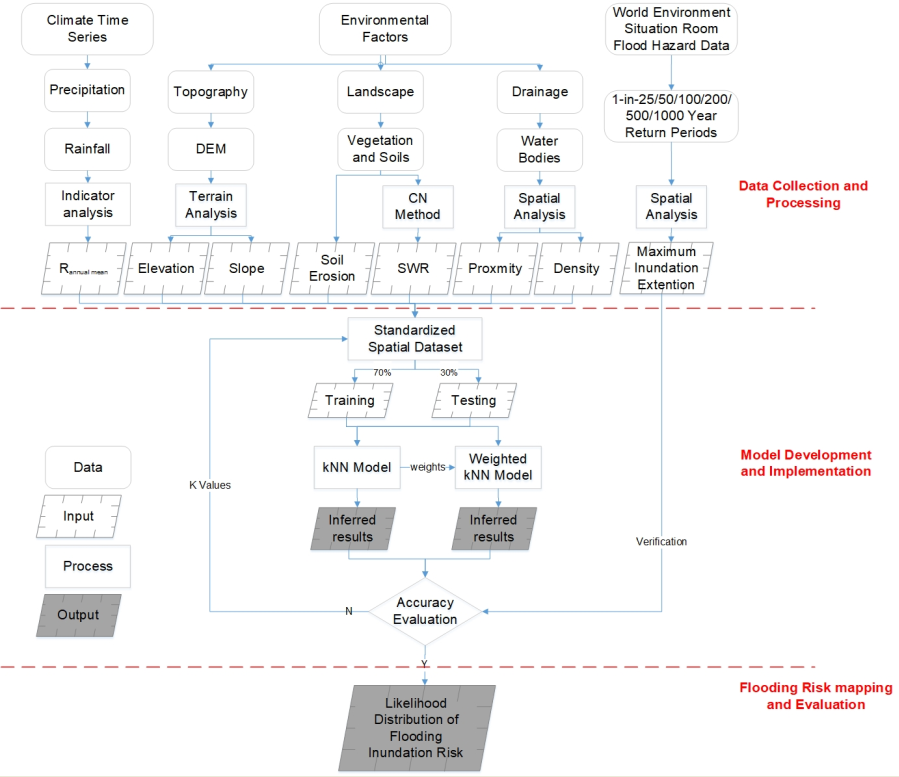
Keywords:
1. Introduction
- Improved the performance of kNN algorithm with a distance-weighted method, and demonstrated the weighed kNN (WkNN) can gain higher accuracy prediction than kNN;
- Developed and applied WkNN-based spatial framework with spatial technologies into flood risk assessment for tourism in coastal areas;
- Due to the limitation of the spatially gridded data, World Environment Situation Room (WESR) was first used in validating flood risk for coastal areas and was demonstrated WESR can be successfully used in flood risk evaluation.
2. Framework Development
2.1. Basic Principle of kNN
- Calculate the pairwise distance between examined objects in testing datasets and k nearby sample neighbors in training datasets;
- Vote the categories of the k nearby samples to confirm the classifications of examined objects.
2.2. Weighted kNN (WkNN)
2.3. Framework Conceptualization
3. Case Study
3.1. Study Area
3.2. Flood-derived Spatial Data Collection and Processing
3.2.1. Detection of Maximum Inundation Extent
3.2.2. Criteria Standardization
4. Result and Discussions
4.1. Result Verification
4.2. Sensitivity Analysis
4.2.1. Sensitivity Analysis in Relation to Sampling Times
4.2.2. Sensitivity Analysis in Relation to Values
4.3. Comparison of WkNN with kNN
4.4. Risk Distribution Analysis
5. Conclusions
Author Contributions
Funding
Acknowledgments
Conflicts of Interest
References
- Papageorgiou, M. Coastal and marine tourism: A challenging factor in Marine Spatial Planning. Ocean & Coastal Management 2016, 129, 44–48. [Google Scholar] [CrossRef]
- Chen, Y.H.; Kim, J.; Mueller, N. Estimating the economic impact of natural hazards on shared accommodation in coastal tourism destinations. Journal of Destination Marketing & Management 2021, 21, 100634. [Google Scholar] [CrossRef]
- Lithgow, D.; Martínez, M.L.; Gallego-Fernández, J.B.; Silva, R.; Ramírez-Vargas, D.L. Exploring the co-occurrence between coastal squeeze and coastal tourism in a changing climate and its consequences. Tourism Management 2019, 74, 43–54. [Google Scholar] [CrossRef]
- Perles-Ribes, J.F.; Ramón-Rodríguez, A.B.; Moreno-Izquierdo, L.; Such-Devesa, M.J. Machine learning techniques as a tool for predicting overtourism : The case of Spain. International Journal of Tourism Research 2020, 22, 825–838. [Google Scholar] [CrossRef]
- Junqing, H.; Han, T.; Jiawei, H.; Yanting, M.; Xinxiang, J. Impacts of risk perception, disaster knowledge and emotional attachment on tourists’ behavioral intentions in Qinling Mountain, China. Frontiers in Earth Science 2022, 932. [Google Scholar]
- Morsy, M.; Sayad, T.; Khamees, A.S. Towards instability index development for heavy rainfall events over Egypt and the Eastern Mediterranean. Meteorology and Atmospheric Physics 2019, 132, 255–272. [Google Scholar] [CrossRef]
- Zhang, Y.; Wang, Y.; Chen, Y.; Xu, Y.; Zhang, G.; Lin, Q.; Luo, R. Projection of changes in flash flood occurrence under climate change at tourist attractions. Journal of Hydrology 2021, 595. [Google Scholar] [CrossRef]
- Vitousek, S.; Barnard, P.L.; Fletcher, C.H.; Frazer, N.; Erikson, L.; Storlazzi, C.D. Doubling of coastal flooding frequency within decades due to sea-level rise. Scientific Reports 2017, 7, 1399. [Google Scholar] [CrossRef]
- Lyu, H.M.; Wang, G.F.; Cheng, W.C.; Shen, S.L. Tornado hazards on June 23 in Jiangsu Province, China: preliminary investigation and analysis. Natural Hazards 2016, 85, 597–604. [Google Scholar] [CrossRef]
- Kundzewicz, Z.W.; Su, B.; Wang, Y.; Wang, G.; Wang, G.; Huang, J.; Jiang, T. Flood risk in a range of spatial perspectives – from global to local scales. Natural Hazards and Earth System Sciences 2019, 19, 1319–1328. [Google Scholar] [CrossRef]
- Sun, S.; Zhai, J.; Li, Y.; Huang, D.; Wang, G. Urban waterlogging risk assessment in well-developed region of Eastern China. Physics and Chemistry of the Earth, Parts A/B/C 2020, 115. [Google Scholar] [CrossRef]
- Fang, J.; Zhang, C.; Fang, J.; Liu, M.; Luan, Y. Increasing exposure to floods in China revealed by nighttime light data and flood susceptibility mapping. Environmental Research Letters 2021, 16, 104044. [Google Scholar] [CrossRef]
- Kumar, M.D.; Tandon, S.; Bassi, N.; Mohanty, P.K.; Kumar, S.; Mohandas, M. A framework for risk-based assessment of urban floods in coastal cities. Natural Hazards 2021, 110, 2035–2057. [Google Scholar] [CrossRef]
- Lu, Y.; Ren, F.; Zhu, W. Risk zoning of typhoon disasters in Zhejiang Province, China. Natural Hazards and Earth System Sciences 2018, 18, 2921–2932. [Google Scholar] [CrossRef]
- Liang, H.; Zhou, X. Impact of tides and surges on fluvial floods in coastal regions. Remote Sensing 2022, 14. [Google Scholar] [CrossRef]
- Thaler, T.; Seebauer, S. Bottom-up citizen initiatives in natural hazard management: Why they appear and what they can do? Environmental Science & Policy 2019, 94, 101–111. [Google Scholar] [CrossRef]
- Cronin, S.J.; Gaylord, D.R.; Charley, D.; Alloway, B.V.; Wallez, S.; Esau, J.W. Participatory methods of incorporating scientific with traditional knowledge for volcanic hazard management on Ambae Island, Vanuatu. Bulletin of Volcanology 2004, 66, 652–668. [Google Scholar] [CrossRef]
- Lai, X.; Wen, J.; Shan, X.; Shen, L.; Wan, C.; Shao, L.; Wu, Y.; Chen, B.; Li, W. Cost-benefit analysis of local knowledge-based flood adaptation measures: A case study of Datian community in Zhejiang Province, China. International Journal of Disaster Risk Reduction 2023, 87, 103573. [Google Scholar] [CrossRef]
- Mendelsohn, R.; Emanuel, K.; Chonabayashi, S.; Bakkensen, L. The impact of climate change on global tropical cyclone damage. Nature Climate Change 2012, 2, 205–209. [Google Scholar] [CrossRef]
- Baade, R.A.; Baumann, R.; Matheson, V. Estimating the economic impact of natural and social disasters, with an application to hurricane Katrina. Urban Studies 2016, 44, 2061–2076. [Google Scholar] [CrossRef]
- Chen, Y.; Liu, R.; Barrett, D.; Gao, L.; Zhou, M.; Renzullo, L.; Emelyanova, I. A spatial assessment framework for evaluating flood risk under extreme climates. Science of The Total Environment 2015, 538, 512–523. [Google Scholar] [CrossRef] [PubMed]
- Tsai, C.H.; Chen, C.W. Development of a mechanism for typhoon- and flood-risk assessment and disaster management in the hotel industry – A case study of the Hualien area. Scandinavian Journal of Hospitality and Tourism 2011, 11, 324–341. [Google Scholar] [CrossRef]
- Sealy, K.S.; Strobl, E. A hurricane loss risk assessment of coastal properties in the Caribbean: Evidence from the Bahamas. Ocean & Coastal Management 2017, 149, 42–51. [Google Scholar] [CrossRef]
- Shi, Y.; Wen, J.; Xi, J.; Xu, H.; Shan, X.; Yao, Q.; Xia, J. A study on spatial accessibility of the urban tourism attraction emergency response under the flood disaster scenario. Complexity 2020, 2020, 1–9. [Google Scholar] [CrossRef]
- Erena, S.H.; Worku, H.; De Paola, F. Flood hazard mapping using FLO-2D and local management strategies of Dire Dawa city, Ethiopia. Journal of Hydrology: Regional Studies 2018, 19, 224–239. [Google Scholar] [CrossRef]
- Yildirim, E.; Demir, I. An integrated web framework for HAZUS-MH flood loss estimation analysis. Natural Hazards 2019, 99, 275–286. [Google Scholar] [CrossRef]
- Chen, Y.; Wang, Y.; Zhang, Y.; Luan, Q.; Chen, X. Flash floods, land-use change, and risk dynamics in mountainous tourist areas: A case study of the Yesanpo Scenic Area, Beijing, China. International Journal of Disaster Risk Reduction 2020, 50, 101873. [Google Scholar] [CrossRef]
- Liu, R.; Chen, Y.; Wu, J.; Gao, L.; Barrett, D.; Xu, T.; Li, X.; Li, L.; Huang, C.; Yu, J. Integrating entropy-based naive Bayes and GIS for spatial evaluation of flood hazard. Risk Analysis 2017, 37, 756–773. [Google Scholar] [CrossRef]
- Liu, R.; Chen, Y.; Wu, J.; Gao, L.; Barrett, D.; Xu, T.; Li, L.; Huang, C.; Yu, J. Assessing spatial likelihood of flooding hazard using naïve Bayes and GIS: a case study in Bowen Basin, Australia. Stochastic Environmental Research and Risk Assessment 2015, 30, 1575–1590. [Google Scholar] [CrossRef]
- Stefanidis, S.; Stathis, D. Assessment of flood hazard based on natural and anthropogenic factors using analytic hierarchy process (AHP). Natural Hazards 2013, 68, 569–585. [Google Scholar] [CrossRef]
- Liu, S.; Liu, R.; Tan, N. A spatial improved-kNN-based flood inundation risk framework for urban tourism under two rainfall scenarios. Sustainability 2021, 13, 2859. [Google Scholar] [CrossRef]
- Liu, K.; Yao, C.; Chen, J.; Li, Z.; Li, Q.; Sun, L. Comparison of three updating models for real time forecasting: a case study of flood forecasting at the middle reaches of the Huai River in East China. Stochastic Environmental Research and Risk Assessment 2016, 31, 1471–1484. [Google Scholar] [CrossRef]
- Liu, K.; Li, Z.; Yao, C.; Chen, J.; Zhang, K.; Saifullah, M. Coupling the k-nearest neighbor procedure with the Kalman filter for real-time updating of the hydraulic model in flood forecasting. International Journal of Sediment Research 2016, 31, 149–158. [Google Scholar] [CrossRef]
- Cassalho, F.; Beskow, S.; Mello, C.R.; Moura, M.M.; Oliveira, L.F.; Aguiar, M.S. Artificial intelligence for identifying hydrologically homogeneous regions: A state-of-the-art regional flood frequency analysis. Hydrological Processes 2019, 33, 1101–1116. [Google Scholar] [CrossRef]
- Aryal, S.; Ting, K.M.; Washio, T.; Haffari, G. A comparative study of data-dependent approaches without learning in measuring similarities of data objects. Data Mining and Knowledge Discovery 2019, 34, 124–162. [Google Scholar] [CrossRef]
- Rodrigues, É.O. Combining Minkowski and Chebyshev: New distance proposal and survey of distance metrics using k-nearest neighbours classifier. Pattern Recognition Letters 2018, 110, 66–71. [Google Scholar] [CrossRef]
- Kutyłowska, M. K-Nearest Neighbours method as a tool for failure rate prediction. Periodica Polytechnica Civil Engineering 2017, 62, 318–322. [Google Scholar] [CrossRef]
- Lantz, B. Machine learning with R: expert techniques for predictive modeling; Packt publishing ltd: 2019.
- Malekinezhad, H.; Sepehri, M.; Pham, Q.B.; Hosseini, S.Z.; Meshram, S.G.; Vojtek, M.; Vojteková, J. Application of entropy weighting method for urban flood hazard mapping. Acta Geophysica 2021, 69, 841–854. [Google Scholar] [CrossRef]
- Rahman, A.S.; Rahman, A. Application of principal component analysis and cluster analysis in regional flood frequency analysis: A case study in New South Wales, Australia. Water 2020, 12. [Google Scholar] [CrossRef]
- Fang, Y.; Yin, J.; Wu, B. Flooding risk assessment of coastal tourist attractions affected by sea level rise and storm surge: a case study in Zhejiang Province, China. Natural Hazards 2016, 84, 611–624. [Google Scholar] [CrossRef]
- Papaioannou, G.; Vasiliades, L.; Loukas, A. Multi-criteria analysis framework for potential flood prone areas mapping. Water Resources Management 2015, 29, 399–418. [Google Scholar] [CrossRef]
- Xiao, Y.; Yi, S.; Tang, Z. Integrated flood hazard assessment based on spatial ordered weighted averaging method considering spatial heterogeneity of risk preference. Science of the Total Environment 2017, 599-600, 1034–1046. [Google Scholar] [CrossRef] [PubMed]
- Yatagai, A.; Kamiguchi, K.; Arakawa, O.; Hamada, A.; Yasutomi, N.; Kitoh, A. APHRODITE: constructing a long-term daily gridded precipitation dataset for Asia based on a dense network of rain gauges. Bulletin of the American Meteorological Society 2012, 93, 1401–1415. [Google Scholar] [CrossRef]
- Tao, G.; Lian, X. Study on progress of the trends and physical causes of extreme precipitation in China during the last 50 years. Advances in Earth Science 2014, 29, 577. [Google Scholar]
- Feng, L.; Hong, W. Characteristics of drought and flood in Zhejiang Province, East China: past and future. Chinese Geographical Science 2007, 17, 257–264. [Google Scholar] [CrossRef]
- Ouma, Y.; Tateishi, R. Urban flood vulnerability and risk mapping using integrated multi-parametric AHP and GIS: methodological overview and case study assessment. Water 2014, 6, 1515–1545. [Google Scholar] [CrossRef]
- Lyu, H.M.; Sun, W.J.; Shen, S.L.; Arulrajah, A. Flood risk assessment in metro systems of mega-cities using a GIS-based modeling approach. Science of The Total Environment 2018, 626, 1012–1025. [Google Scholar] [CrossRef]
- McCuen, R.H. A guide to hydrologic analysis using SCS methods; Prentice-Hall, Inc.: 1982.
- Viji, R.; Rajesh Prasanna, P.; Ilangovan, R. GIS based SCS-CN method for estimating runoff in Kundahpalam watershed, Nilgries District, Tamilnadu. Earth Sciences Research Journal 2015, 19, 59–64. [Google Scholar]
- Cao, B.; Yu, L.; Naipal, V.; Ciais, P.; Li, W.; Zhao, Y.; Wei, W.; Chen, D.; Liu, Z.; Gong, P. A 30 m terrace mapping in China using Landsat 8 imagery and digital elevation model based on the Google Earth Engine. Earth System Science Data 2021, 13, 2437–2456. [Google Scholar] [CrossRef]
- SCS, Soil Conservation Service. Urban hydrology for small watersheds SCS; Engineering Division, Soil Conservation Service, US Department of Agriculture: 1986.
- Kazakis, N.; Kougias, I.; Patsialis, T. Assessment of flood hazard areas at a regional scale using an index-based approach and Analytical Hierarchy Process: Application in Rhodope-Evros region, Greece. Science of the Total Environment 2015, 538, 555–563. [Google Scholar] [CrossRef]
- Strahler, A.N. Quantitative geomorphology of drainage basin and channel networks. Handbook of Applied Hydrology 1964. [Google Scholar]
- Andreadis, K.M.; Schumann, G.J.P.; Pavelsky, T. A simple global river bankfull width and depth database. Water Resources Research 2013, 49, 7164–7168. [Google Scholar] [CrossRef]
- Park, S.; Oh, C.; Jeon, S.; Jung, H.; Choi, C. Soil erosion risk in Korean watersheds, assessed using the revised universal soil loss equation. Journal of Hydrology 2011, 399, 263–273. [Google Scholar] [CrossRef]
- Li, X.; Wei, X. Analysis of the relationship between soil erosion risk and surplus floodwater during flood season. Journal of Hydrologic Engineering 2014, 19, 1294–1311. [Google Scholar] [CrossRef]
- Jabbour, J.; Caldas, A.; Peduzzi, P. The World Environment Situation Room: rethinking environmental assessment. In Proceedings of the AGU Fall Meeting Abstracts; pp. 11–0932.
- Dottori, F.; Salamon, P.; Bianchi, A.; Alfieri, L.; Hirpa, F.A.; Feyen, L. Development and evaluation of a framework for global flood hazard mapping. Advances in Water Resources 2016, 94, 87–102. [Google Scholar] [CrossRef]
- Foody, G.M. Status of land cover classification accuracy assessment. Remote Sensing of Environment 2002, 80, 185–201. [Google Scholar] [CrossRef]
- Liu, C.; Frazier, P.; Kumar, L. Comparative assessment of the measures of thematic classification accuracy. Remote sensing of environment 2007, 107, 606–616. [Google Scholar] [CrossRef]
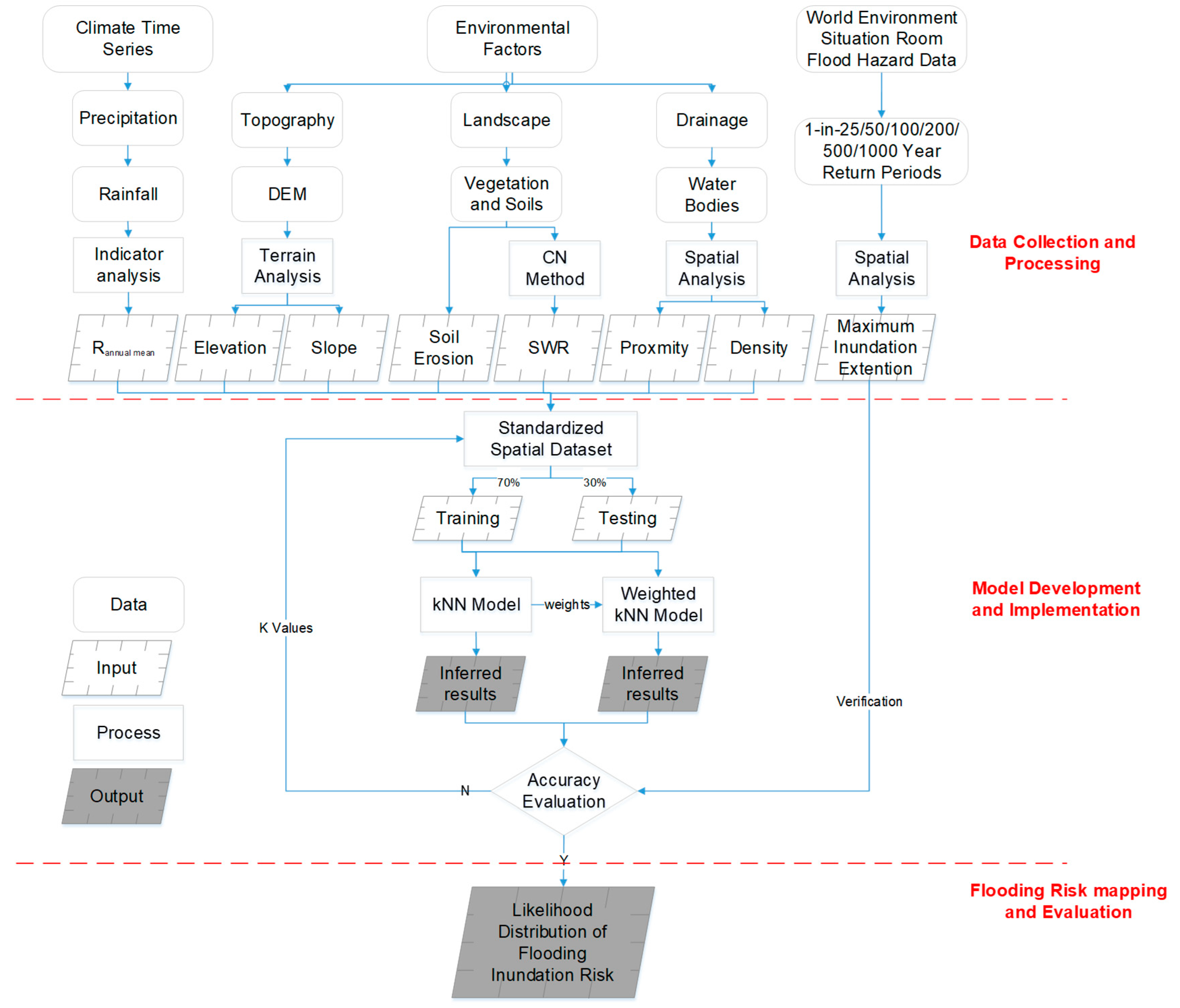
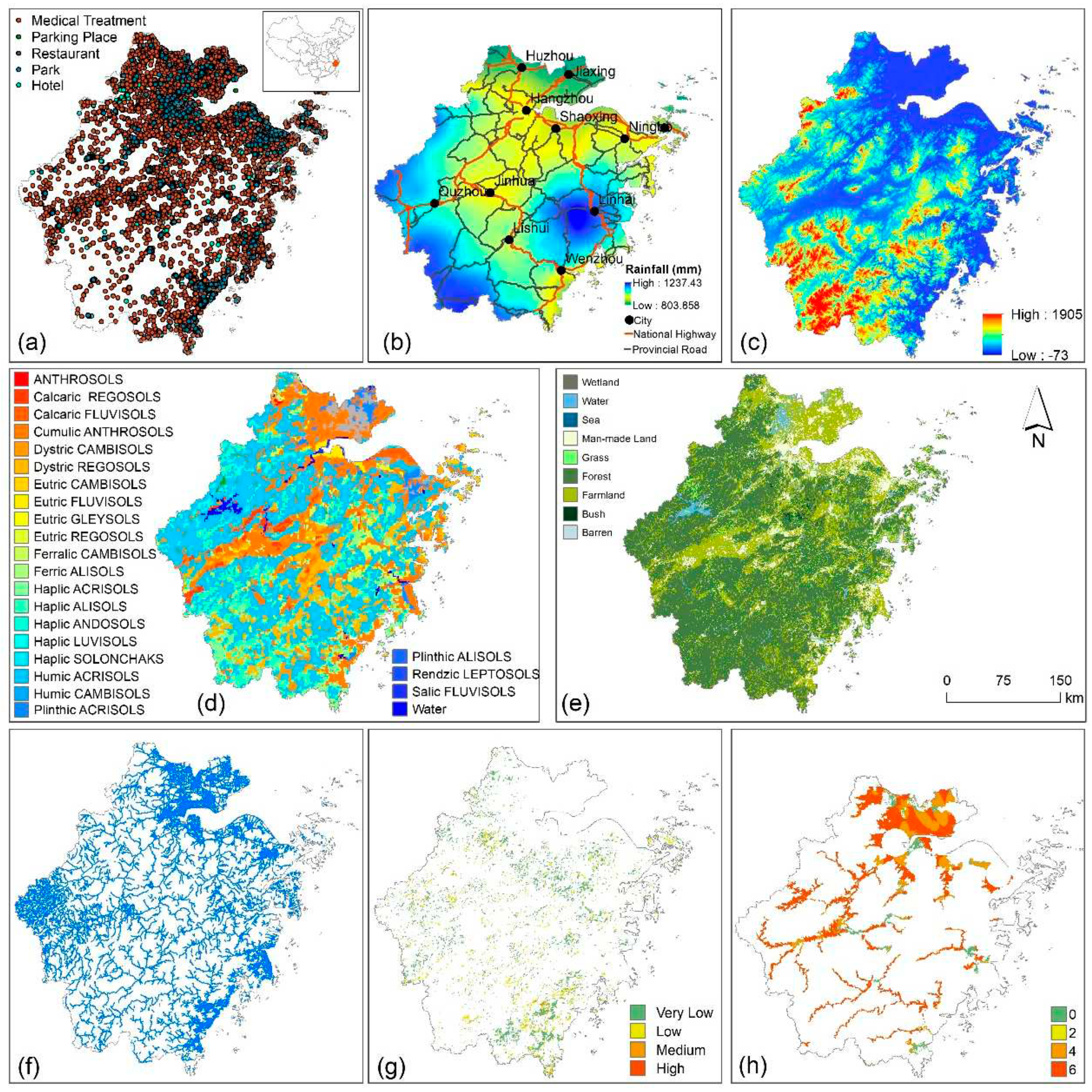
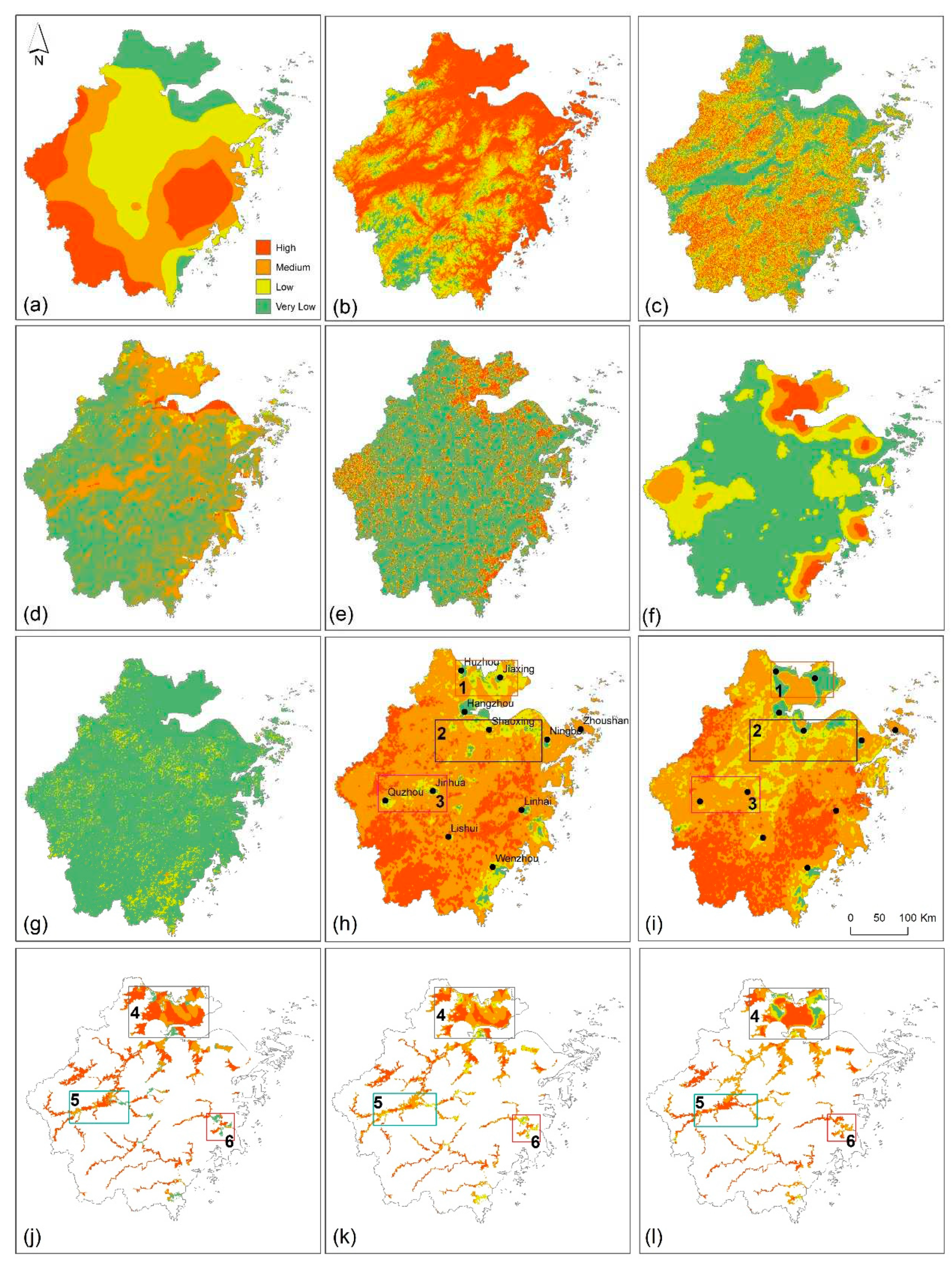
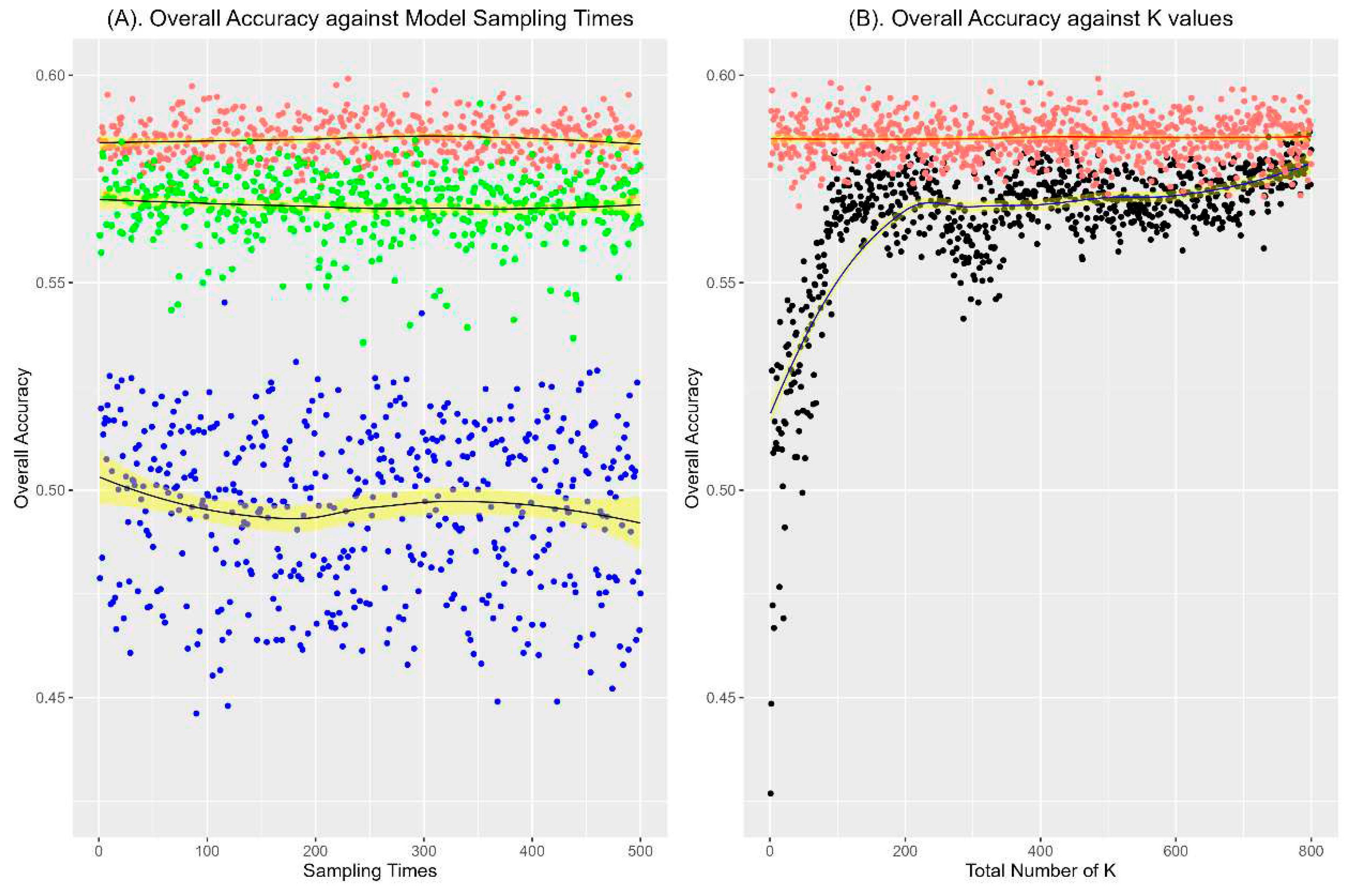
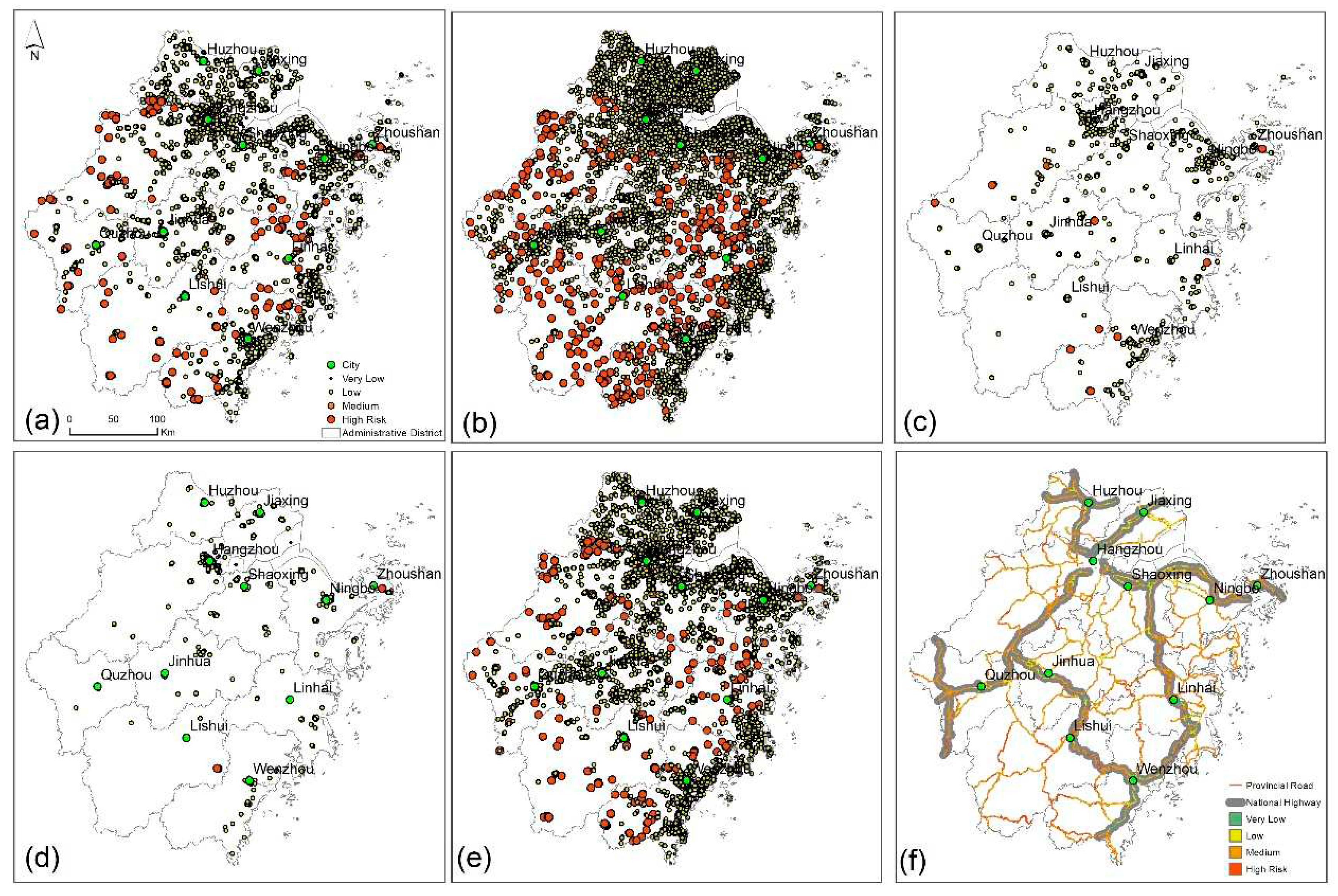
| Soil Type | A | B | C | D |
|---|---|---|---|---|
| Farmland | 72 | 82 | 88 | 92 |
| Forest | 36 | 60 | 73 | 79 |
| Grass | 39 | 61 | 74 | 80 |
| Bush | 36 | 60 | 74 | 80 |
| Wetland | 32 | 58 | 72 | 79 |
| Man-made Land | 89 | 92 | 94 | 95 |
| Barren | 72 | 82 | 88 | 90 |
| Water | 100 | 100 | 100 | 100 |
Disclaimer/Publisher’s Note: The statements, opinions and data contained in all publications are solely those of the individual author(s) and contributor(s) and not of MDPI and/or the editor(s). MDPI and/or the editor(s) disclaim responsibility for any injury to people or property resulting from any ideas, methods, instructions or products referred to in the content. |
© 2023 by the authors. Licensee MDPI, Basel, Switzerland. This article is an open access article distributed under the terms and conditions of the Creative Commons Attribution (CC BY) license (http://creativecommons.org/licenses/by/4.0/).




